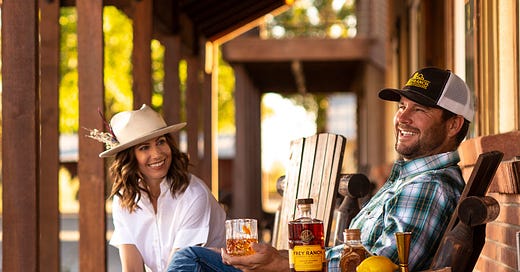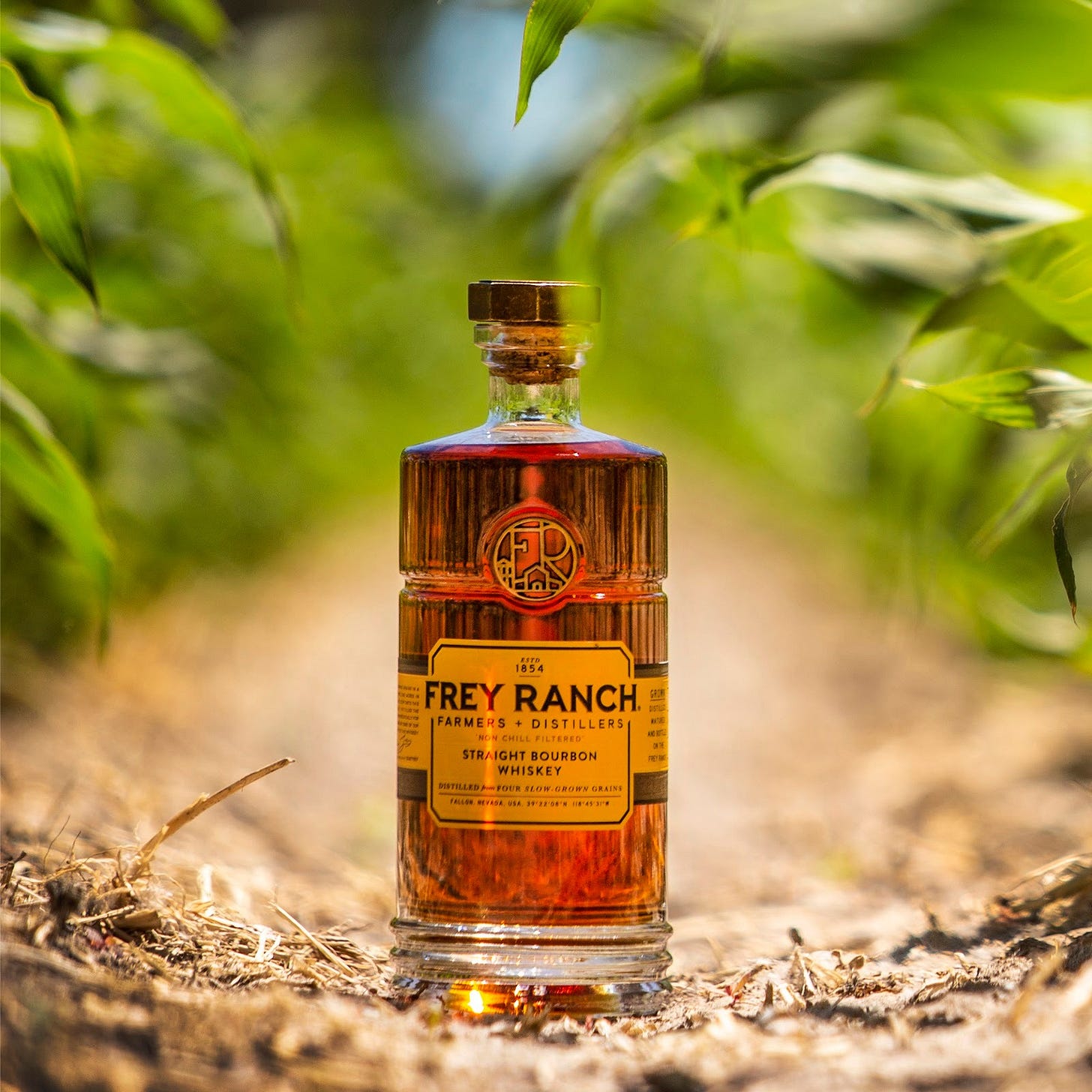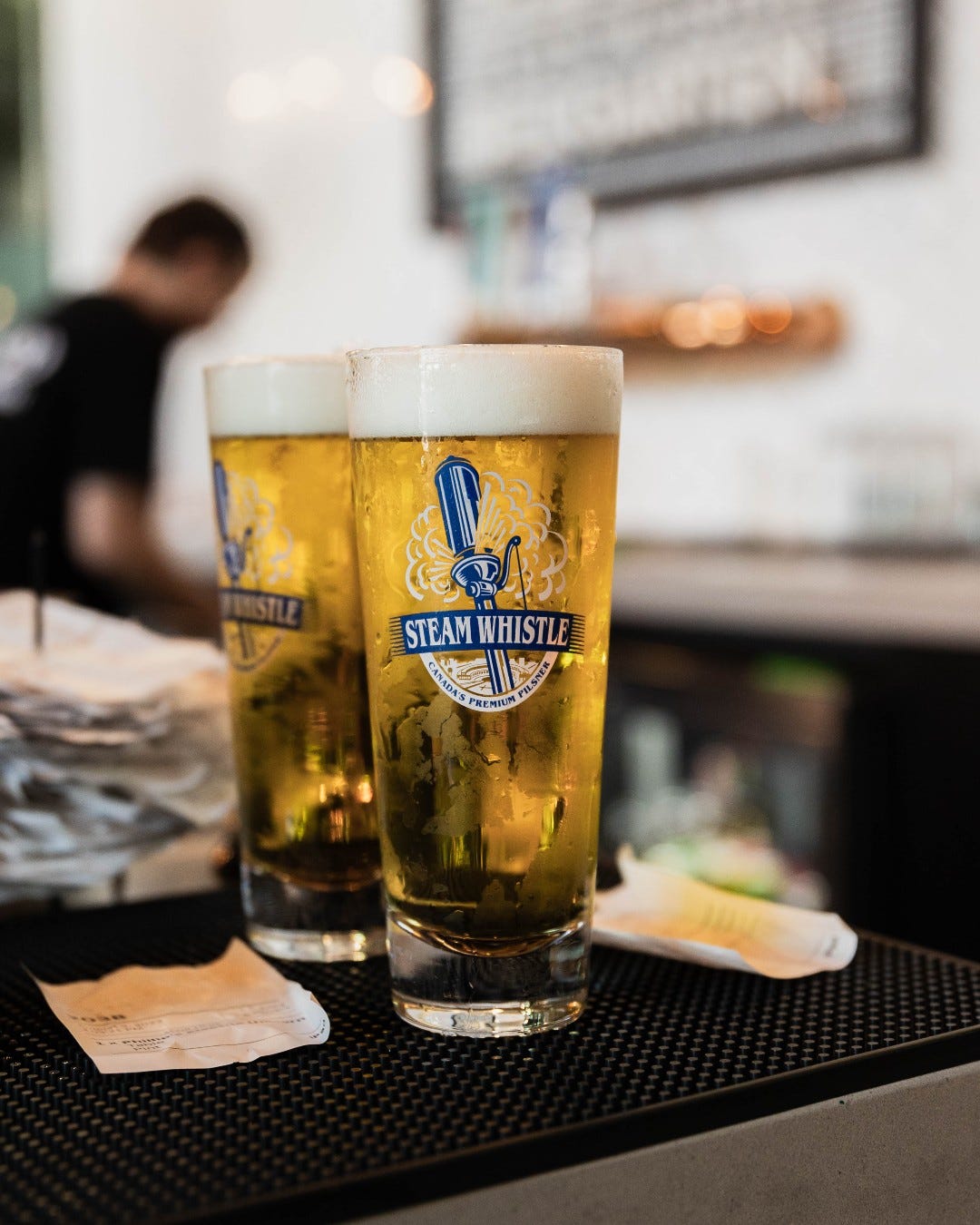Issue #6: A Whiskey Oasis in Nevada
Frey Ranch uses 160 years of farming knowledge to put Nevada crops in a bottle
The first thing to come to mind when you think about Nevada is definitely not agriculture.
Even as someone who lived in Las Vegas for nearly five years, I hardly think of the state as a place friendly to plant growth. However, while living out there, I tried an incredible Nevada-based whiskey company called Frey Ranch Farmers & Distillers.
And, as it turns out, everything that goes into a Frey Ranch whiskey is grown right on-site in Fallon, Nevada, a little oasis in the massive desert state.
I recently chatted with co-founder Colby Frey, a fifth-generation farmer on the ranch. Colby and his wife, Ashley, founded the whiskey brand in 2006.
Note: We’ll have our first paid post this week with Ed's essay about making toast.
Growing whiskey in Nevada
To understand Colby Frey’s whiskey ambitions is to go back 165 years to when his family first started farming in Fallon, Nevada.
Nevada doesn’t have the agricultural heritage of other states, particularly neighboring California or my home state of Michigan. As it turns out, agriculture is a fairly significant industry in Nevada — largely cattle ranches.
But Fallon, about 60 miles east of Reno, is at the nexus of the Carson and Truckee rivers.
“I’m pretty sure our county has three times more water than the rest of Nevada combined. It’s that beautiful Sierra snowmelt,” Colby said while on the phone from his truck as he took a reprieve from digging ditches on the ranch. “We’re a beautiful, lush, green valley but if you go 10, 15 miles outside any direction, it’s just dirt.”
Since the Freys settled in Fallon, back in 1854, they’ve fine-tuned how to grow grain in the Nevada climate and honed in on the soil and irrigation. Barley, wheat and corn have always grown on the ranch, and as it continued to be extremely high quality, Colby wanted to find a showcase for the grains.
“I wanted to do something meaningful, it’s every farmers dream to do something meaningful and have a final product to showcase it with,” he said. “We put so much work, so much labor of love just growing crops. When you sell it on the open market, you don’t get to see the final product. It’s just not as fulfilling.”
Some giant whiskey brands, like Four Roses, showcase their mash bills and explain the taste differences. However, those grains are brought in from all over North America and lack a true backstory. Other distilleries are more focused on the notes a barrel imparts over the years of aging.
But as an estate distillery, Frey Ranch has input in every part of the process and knows exactly what went into the grains and, ultimately, the whiskey.
As the distillery got off the ground, they distilled spirits with mash bills of 100% corn, 100% rye, 100% barley and 100% rye to see what the grains tasted like.
“I really wanted to taste each grain by itself, and now when I taste one of our whiskeys, I can taste all four separately,” Colby said. “Most distilleries don’t talk about that. In the wine world, terroir is huge, and without grains, you can’t have whiskey, it’s the base ingredient. I don’t understand why it’s not more common.”
He said he’s spoken to Kentucky distillers who say mash bills don’t really matter. And that led us to a discussion about the commoditization of the 20th century. How life went from a variety of products made locally to supermarket staples — say Wonder Bread or Budweiser.
“A hundred, 150 years ago, there were a lot of farm distilleries and they did it on their own and then the industry was commercialized and all the small farmers were pushed out,” Colby said. “There was a generation that got away from caring about what they put in their bodies. My parents thought it was a treat to go to Denny’s. They wanted consistency and commercialization. We’re going back to the way things were, the farmers market, the foodie group.
“You start with a better product, a better meal, a better restaurant.”
Frey Ranch is still growing. The 2,500 acres of land are laying down about 110,000 cases of whiskey at the moment. For now, they bottle about 25,000 cases a year and send them to 10 states.
There are rotational crop necessities to ensure the land stays suitable for growing (Frey Ranch also grows alfalfa, which helps reset the land and sends it all over the world including Dubai, China and Japan). So not all 2,500 acres are available for whiskey grains every year.
Still, if the ranch reaches its full capacity and Colby’s dream of sending his whiskey to all 50 states comes true, they can double that 110,000 case production number.
“That’s my dream, maybe not all 50, but I want to be able to go into different states, walk into a bar and see my product,” he said. “It’s fun for me to get off the farm and see the world.”
Literary Libations
Hi friends! It’s Alyssa here with another edition of Literary Libations — your go-to book and cocktail pairings.
Let me start by saying I am typically not an audiobook reader. Since it’s not wholly immersive the way traditional reading is, I find it hard to pay close attention to what I’m hearing and my brain ends up wandering based on whatever activity I’m physically doing. However, I lately got the urge to reread some of my all-time favorite books, but had a hard time justifying spending so many hours on a book I already read while I have a hundreds-book-long TBR (literally). Enter the audiobook! While taking my hot girl walks (my dog dragging me around the neighborhood), I pop in my headphones and listen to books I’ve already loved and read. And if my mind wanders, I already know what’s happening so it’s low stakes. It’s been a joy to experience these books in a new way and makes my walks much less boring.
This newfound (to me) book consumption technique has led me back to the Beartown trilogy by Fredrick Backman. The three books are hands down some of my favorites of all time, and Backman is easily one of the best writers of our time. Taking place in a fictional hockey-obsessed town in northern Sweden, the series explores the light and dark sides of hockey, how it can tear a community apart and bring it back together, and the resilience of the human spirit. The story is breathtaking, the characters beautifully flawed, the writing unmatched. I can go on for another couple thousand words, but I’ll give you what you came here for now.
Benji’s Nordic Negroni
1 oz aquavit
1 oz Campari
1 oz sweet vermouth
Orange bitters
Orange peel
Method: Mix aquavit, Campari, vermouth and orange bitters in a rocks glass with a large ice cube. Stir until well-chilled. Garnish with an orange peel. Enjoy while reading the Beartown series (IF YOU HAVE YET TO DO SO YOU MUST).
What’s Pat Drinking
This week I ended up in Toronto for another work trip. It was a quick one, but I was able to stop at Steam Whistle Brewing, the largest independent brewery in Toronto.
It was actually my second time at the brewery for a few reasons. One, it’s in a historic train station called John Street Roundhouse.
Two, they live by the tagline “Do one thing really, really, well.”
And that they do. In my beer journey, I’ve come full circle and mostly love a well-brewed pilsner. And all they make is pilsner. It might be the best pilsner brewed in North America. (I also drank a cold, frosty mug after a disgustingly hot and humid walk from the hotel… but it is really good!)
I also have a soft spot in my heart for Miller High Life. The bottles are just so refreshing. But what’s even more refreshing? A spaghett!
It’s real easy too. Take a sip, a big one, out of the High Life bottle. Fill back up with Campari or Aperol and a squeeze of lemon. Devine.
Pickleball hits the bar?
As the Beer City Open returns in July to Grand Rapids (recently named the “third most pickleball-obsessed city” in the US), I got a pitch about the Amway Grand Plaza offering pickleball-inspired cocktails.
It included Volley Llama at MDRD, the Shake and Bake-N at Lumber Baron Bar and In the Kitchen at The Kitchen By Wolfgang Puck. Dink responsibly!









